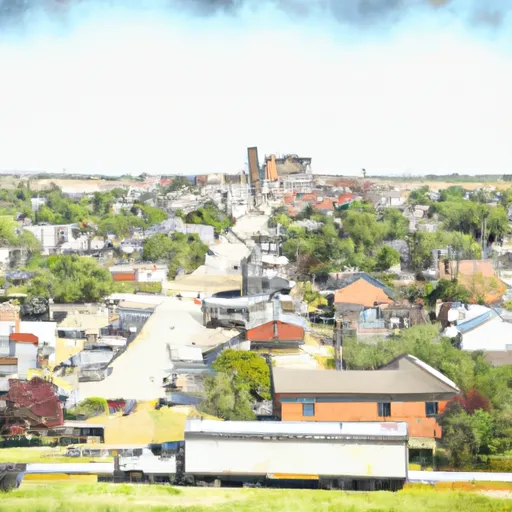-
 Snoflo Premium
Snoflo Premium
Get unlimited access to all our content
With no Ad interruptions! - Start Your Free Trial Login with existing account
Longford
Eden Index
Climate
9.9
•
Recreation
•
Community
•
Safeguard
4.0/10

Longford, Kansas is a small town located in Clay County. It experiences a continental climate, with hot summers and cold winters. Summers are typically hot, with temperatures reaching into the high 90s°F (mid 30s°C), while winters are cold, with temperatures dropping below freezing. The area receives moderate rainfall throughout the year, with occasional thunderstorms during summer.
Hydrology constituents in Longford primarily revolve around the Chapman Creek, which flows through the town. The creek supports a variety of aquatic life and serves as a water source for the community. Additionally, the nearby Milford Lake is a popular destination for outdoor enthusiasts. As Kansas' largest lake, it offers opportunities for fishing, boating, swimming, and camping.
Longford itself offers recreational activities such as hiking, bird watching, and picnicking in the scenic landscapes surrounding the town. The Clay County State Lake is another outdoor attraction, providing opportunities for fishing and boating. With its diverse natural offerings and a tranquil atmosphere, Longford is an excellent destination for those seeking outdoor adventures in the heart of Kansas.
What is the Eden Index?
The Snoflo Eden Index serves as a comprehensive rating system for regions, evaluating their desirability through a holistic assessment of climate health, outdoor recreation opportunities, and natural disaster risk, acknowledging the profound impact of these factors on livability and well-being.
Climate Health Indicator (CHI): 9.9
Longford receives approximately
766mm of rain per year,
with humidity levels near 72%
and air temperatures averaging around
13°C.
Longford has a plant hardyness factor of
6, meaning
plants and agriculture in this region thrive during a short period during spring and early summer. Most
plants will die off during the colder winter months.
By considering the ideal temperature range, reliable water supplies, clean air, and stable seasonal rain or snowpacks, the Climate Health Indicator (CHI) underscores the significance of a healthy climate as the foundation for quality living.
A healthy climate is paramount for ensuring a high quality of life and livability in a region, fostering both physical well-being and environmental harmony. This can be characterized by ideal temperatures, reliable access to water supplies, clean air, and consistent seasonal rain or snowpacks.
Weather Forecast
Streamflow Conditions
Smoky Hill
Area Rivers
Smoky Hill
Snowpack Depths
Smoky Hill
Reservoir Storage Capacity
Smoky Hill
Groundwater Levels
Recreational Opportunity Index (ROI):
The Recreational Opportunity Index (ROI) recognizes the value of outdoor recreational options, such as parks, hiking trails, camping sites, and fishing spots, while acknowledging that climate plays a pivotal role in ensuring the comfort and consistency of these experiences.
Access to outdoor recreational opportunities, encompassing activities such as parks, hiking, camping, and fishing, is crucial for overall well-being, and the climate plays a pivotal role in enabling and enhancing these experiences, ensuring that individuals can engage in nature-based activities comfortably and consistently.
Camping Areas
| Campground | Campsites | Reservations | Toilets | Showers | Elevation |
|---|---|---|---|---|---|
| McConnell AFB Military | None | 1,355 ft | |||
| Crystal Springs Lake | 60 | 1,314 ft | |||
| Buckley Creek | 4 | 1,429 ft | |||
| Berner Memorial Campground | None | 1,275 ft | |||
| Huntress City Park | None | 1,202 ft |
Catastrophe Safeguard Index (CSI):
The Catastrophe Safeguard Index (CSI) recognizes that natural disaster risk, encompassing floods, fires, hurricanes, and tornadoes, can drastically affect safety and the overall appeal of an area.
The level of natural disaster risk in a region significantly affects safety and the overall livability, with climate change amplifying these risks by potentially increasing the frequency and intensity of events like floods, fires, hurricanes, and tornadoes, thereby posing substantial challenges to community resilience and well-being.
Community Resilience Indicator (CRI):
The Community Resilience Indicator (CRI) recognizes that education, healthcare, and socioeconomics are crucial to the well-being of a region. The CRI acknowledges the profound impact of these elements on residents' overall quality of life. By evaluating educational resources, healthcare accessibility, and economic inclusivity, the index captures the essential aspects that contribute to a thriving community, fostering resident satisfaction, equity, and social cohesion.

